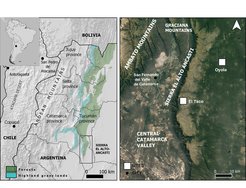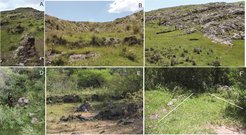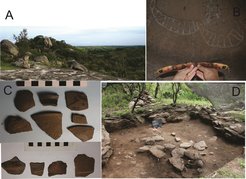Pre-Columbian Landscape Management in the Seasonally Dry Forests of Argentina
A team of international researchers, including scholars at the Max Planck Institute for the Science of Human History, outline growing evidence of anthropogenic landscapes in the semi-deciduous tropical forest biomes of northwest Argentina. The paper, published in World Archaeology, shows that human societies inhabiting this region during the first millennium AD (about. 1,500-1,000 years ago) established a strategy of ‘overlapping patchworks’ of food production that were able to contend with considerable seasonal variability
Northwest Argentina experiences stark differences in temperature, rainfall, and vegetation, primarily due to the region’s varying altitude. Varied records of human occupation and adaptation to Neotropical forests reveal the impacts this ecological diversity has had on the human inhabitants of the region.

The most conspicuous archaeological evidence of anthropogenic landscapes in the El Alto-Ancasti mountain range relates to the so-called "La Aguada Culture”. It has been argued that polities from Northwest Argentina participated in long-distance trade with Tiwanaku societies of the Bolivian high-plateaus by roughly 1,500 years ago. Between 1,400 and 1,200 years ago, this seems to have achieved its maximum extent through trade with more distant regions. These exchanges saw distinctive pottery, snuff paraphernalia and the pods of the cebil tree (Anadenanthera colubrina var. cebil) travel vast distances. This well-documented trade in cebil seeds hints at the important role forest management must have had for communities across a vast area.
In the new paper, the researchers explored the significance of the varied forest environments to human societies in more detail by undertaking a multidisciplinary approach to the study of past soil management and crop cultivation in El Alto-Ancasti. The direct sampling of agricultural fields in both the grasslands (El Taco) and in the forests (Oyola) identified crop taxa and several management techniques in two localities showing contemporaneous residential sites.
Cultivated plots were found in ravines associated with habitation sites and showed that, in both grasslands and forests, agricultural systems were primarily characterized by rainfed runoff farming across heterogenous biomes of grasslands and forests and the controlled use of fire. The abundant presence of important ritual species in the forests, such as cebil, suggests a particular dynamic for agroforestry techniques, whereby certain species were protected.

Overlapping patchworks of agrarian landscapes in eastern Northwest Argentina

The multidisciplinary review and analysis suggest that a close understanding and managing of Andean environmental variability developed in the El Alto-Ancasti mountain range between roughly 1,500 and 1,000 years ago. This departs from what is predicted by the altitudinal zone model, commonly used by archaeologists to determine how economies varied between different environments. A focus on altitudinal variation between environments and human adaptations has been particularly strong in the Andes, where the altitudinal belts which span from high montane forests and grasslands down to evergreen rainforests are considered crucial to human economic and political development.
However, as the team observed here, instead of generating differentiated, specialized techniques for each microenvironment, the Indigenous communities that populated the mountain slope in El Alto-Ancasti developed very similar patchworks of anthropogenic landscapes, where the agricultural structures and the current taxa were found to be similar in both highland grassland and forest contexts (maize, cucurbits, legumes, tubers). This work highlights that the altitudinal zone model is not purely dictated by Andean environmental variability. Indeed, this is simply the starting point for exploring how local communities, past and present, adapt food production strategies to varied and changing tropical and sub-tropical landscapes.
This research demonstrates the need to abandon environmentally deterministic models of human adaptation and settlement in the Neotropics, and adds to the emerging evidence from the Amazon Basin in highlighting the long legacy of Indigenous forest management in South America. In so doing, it provides focus on the ways Indigenous populations managed and manipulated a diversity of landscapes and the lasting legacies and implications these techniques have for 21st century ecology and conservation.


